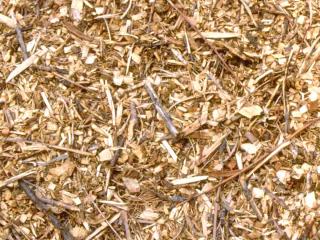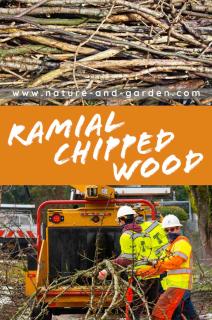

BRF is a common term in forestry. It is derived from the French “Bois Raméal Fragmenté”, or Ramial Chipped Wood. Anybody can make this mulch from crushed and shredded green wood branches. It’s the best mulch for enriching and protecting garden soil.
While still under the radar of the public at large, BRF/RCW is a technique known to organic gardeners the world over. Canadian scientists developed and studied the practice in the 1990s.

Indeed, like any other mulch, BRF (or RCW in English) protects soil from erosion, evaporation and inhibits weed growth. On top of that, it retains water very well. Young branches tend to contain a great many nutrients: that’s where buds, leaves and flowers are located. These nutrients are transformed by underground fauna and flora (worms, fungus, thrips…). In the end, everything breaks down into organic building blocks that enrich, aerate the soil and balance its pH.
Result: beautiful, healthy plants and more productive fruits and vegetables.
BRF / RCW is thus particularly well suited to poor soil, especially if sandy, clayish or chalky.

Spread the mulch in a layer 1 to 2 inches (2 to 5 cm) thick atop your flower beds, future vegetable beds and fruit beds.
Lather it under your trees and shrubs – don’t cover the soil right around the trunk though, to keep the root crown free. Run the cultivator along the ground to stir in some of the ground bacteria. There’s no need to deep till or turn the ground. That’s all!
You can also add it as an underlayer to plastic sheeting or organic landscaping fabric, or other types of mulch.
After that, simply sow and plant whatever you wish, as usual. Apply a new layer of BRF or RCW atop the previous one in fall of the following year. Wood chips from the first layer will already have been broken down and mingled with the soil.
→ In more detail: best wood to make RWC
Don’t really like the disorderly appearance of mixed chips and leaves? Pair RWC with other types of mulch:
Laure Hamann edited by Gaspard Lorthiois
Sources shared to Nature & Garden:
hello the ramail wood chips can be incorporated to soil and we can directly plant our lettuces or arugula ?
Or we must allow how much time /?
I am reading different articles of this technique and its faboulous for farmers, if you have any univeristy paper to recommend I really appreciate.
Kind regards and thanks.
Hello Madelon, there’s no need to till or plow the soil when applying BRF. You can just settle it all over the vegetable patch. At the beginning, it’ll simply work as mulch does (retaining moisture and such) but then as it starts breaking down it’ll release the soil-nourishing compounds that make it even better than compost. It won’t have an immediate effect, but a year of use will already show great improvement.
The pioneer in this field is Professor Gilles Lemieux, from Laval, Canada. I added a study by him and his colleague Diana Germain as a source at the bottom of the article.
If branches are 2 or 3 years old, do they still have the nutrients in them to be used as ramial wood?
Hello Dan, not as much. The added “extra boost” from Ramial Chipped Wood is in the live plant material. In dead, dried wood this has disappeared. Don’t get me wrong – there are still loads of nutrients in chipped branches, even when they’ve dried out for a couple years. It’s similar, though, to what you’d expect from wood chips.